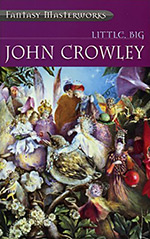
![]() EricLandes
EricLandes
2/20/2014
![]()
Little, Big is, to date, different than anything else I've ever read.
It lacks the typical structure you see in many SFF books, and instead sort of builds on itself as it goes. The prose is much more on the literary side - it's not a quick read, at least for the first third until you get into Crowley's rhythm.
It's sort of an urban fantasy, but sort of not, as the star of the story is really the house in Edgewood, a place that doesn't exist on the map.
Other reviews may tell you things about plot, events, etc. but in this review, I'm going to do something different, and that's explain how the construction of the book mirrors the contents of the book in ways that didn't really hit me until a couple days after I finished the book.
First: one of the prevailing motifs when talking about the world where they (the fey, though they're never referred to by any name I can recall) live is "the further in you go, the bigger it gets." This is certainly true about the nature of the book. The closer you look at specific things, the bigger they get. As examples, I point you to the rest of the points I'll make.
Second: The house in Edgewood mirrors the structure of the story. It rambles, has a different feel in different sections, and (while I haven't checked) I'd be willing to bet the number of chapters and/or parts totals some significant number in nature, such as the 365 steps, 52 doors, seven chimneys, and four floors in the house.
Third: The feel of the story mirrors the title. It's a big book, and at first blush feels like a big story, but then you realize it's actually rather small, and the bigness you felt was only illusory.
Fourth: (or maybe third-and-a-half) While you're reading the book, you feel like you're reading The Tale, the fated future of the family as sort-of-revealed through a rather special tarot-esque deck. It certainly has the aspects of meaningful things not feeling so meaningful at first.
Fifth: Just as the fey are never really glimpsed (with only a couple exceptions), many significant events in the book are only obliquely presented (with only a couple exceptions). An effect also represented by Edgewood only being found by inference: it's not on the maps.
As you can see, my gut feel is that Crowley has managed to construct a self-referential novel. Or, is it onomatopaeic? Recursive? I don't know for sure, but I know I got the feel that when I looked at the book as a whole, the story informed me how the book was constructed. Which is a heck of a writing feat, in my book.
I nearly stopped reading this book twice. Very glad I didn't. Would I recommend it? Not to everyone. It's a challenging read, to be sure. If you sometimes enjoy literary fiction, then give this a shot. If you can't stand that genre, then consider yourself warned if you embark into this story.